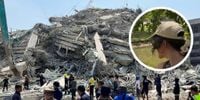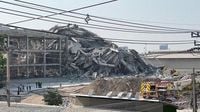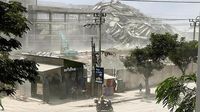On March 28, 2025, a powerful magnitude 7.7 earthquake struck Southeast Asia, with its epicenter located in northwestern Burma, approximately 17 kilometers from Mandalay. The tremor was felt strongly across various countries, including Thailand, where the capital city, Bangkok, experienced significant devastation. Reports indicate that at least three people died, 50 were injured, and around 70 are missing following the collapse of a building under construction in the Chatuchak area, a popular district known for its street market.
Eyewitness accounts detail the chaos that ensued as the earthquake hit shortly after 12:50 PM local time. Among those affected was Carmen S., a Spanish tourist who was in Bangkok on her last day in Thailand. "We were in our hotel room, on the fifth floor, when everything started shaking suddenly," Carmen recounted in an interview with ABC. "We looked out the window and saw trees swaying back and forth, so we decided to get to the street quickly, just in case." This instinct proved wise, as alarms began ringing 15 minutes later, prompting evacuations of nearby buildings.
Carmen described the scene on the streets as thousands of people gathered outside, waiting for what was initially expected to be a one-hour evacuation period from 2:00 PM to 3:00 PM. "It turned into quite a long wait, and it was extremely hot outside. The streets were packed, and the few cafes that were open had long lines," she said. However, by around 5:00 PM, the situation had calmed down significantly, with buildings reopening and people returning to their routines, albeit with a lingering sense of unease.
As the dust settled, officials began assessing the damage. The governor of Bangkok, Chadchart Sittipunt, confirmed the tragic toll of the collapsed building, which was still under construction at the time of the earthquake. The Prime Minister of Thailand, Paetongtarn Shinawatra, declared Bangkok a "catastrophic zone," highlighting the severity of the situation. The stock exchange in Bangkok suspended operations as a precautionary measure.
In Burma, the situation was even more dire. The military junta reported at least 144 fatalities and 732 injuries across the country, with many victims trapped under the rubble of collapsed structures. Hospitals in Mandalay, the earthquake's epicenter, were overwhelmed with injured individuals, many receiving treatment in the streets due to the sheer number of casualties. A mosque roof collapsed during Friday prayers in a nearby village, resulting in additional fatalities.
Witnesses in Mandalay reported severe damage to historical sites, including parts of the Palace of Mandalay, and the destruction of a bridge in Sagaing. The earthquake's depth was measured at 10 kilometers, making it one of the strongest seismic events to hit the region in recent years. The tremor was initially reported as measuring 8.2 degrees by Thai authorities before being adjusted to 7.7.
In Bangkok, the collapse of the skyscraper in Chatuchak left 114 workers missing, comprising both Thai nationals and foreign laborers. Rescue operations were immediately launched, but hopes of finding survivors were dwindling as time passed. The military junta in Burma declared a state of emergency in six central regions, indicating the gravity of the crisis and the need for international assistance.
As Carmen prepared for her flight back to Spain, scheduled for 3:00 AM, she expressed her concerns about reaching the airport amid the chaos. "Traffic is usually bad, but now it's impossible to imagine how long it will take to get there," she said, reflecting on the challenges posed by the aftermath of the quake.
Despite the destruction, many residents in Bangkok displayed remarkable resilience. Streets that had once been bustling with activity were now filled with people anxiously awaiting news about loved ones and the fate of their city. As the hours passed, some began to resume their daily activities, albeit with a heightened awareness of the potential for aftershocks. The Department of Meteorology warned residents to remain cautious, advising them to stay outdoors until the risk of further tremors had subsided.
In the days following the earthquake, authorities urged citizens to prepare for possible aftershocks, as a 6.4 magnitude tremor was felt in Chiang Mai, a northern city in Thailand. The Bangkok Stock Exchange remained closed, and public transport systems, including the metro and elevated train services, were temporarily suspended as safety inspections were conducted.
International responses began to pour in, with neighboring countries expressing their willingness to provide aid and support. The Thai government coordinated with relief agencies to assess the needs of those affected and to facilitate rescue operations. Meanwhile, the embassy in Bangkok reported no incidents involving Spanish nationals, offering some reassurance amidst the chaos.
As night fell over Bangkok, the city remained on edge, with many residents choosing to sleep outdoors rather than risk returning to potentially unsafe buildings. The earthquake had shaken not only the ground beneath them but also the very fabric of their daily lives.
In summary, the March 28 earthquake serves as a stark reminder of the region's vulnerability to natural disasters. As recovery efforts continue, the resilience of the affected communities will be tested in the days and weeks ahead. The stories of those like Carmen S., who experienced the tremor firsthand, will remain etched in the memories of many, underscoring the unpredictable nature of life in a seismically active area.






